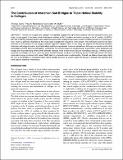| dc.contributor.author | Gurry, Thomas | |
| dc.contributor.author | Nerenberg, Paul S. | |
| dc.contributor.author | Stultz, Collin M. | |
| dc.date.accessioned | 2012-10-02T12:32:42Z | |
| dc.date.available | 2012-10-02T12:32:42Z | |
| dc.date.issued | 2009-11 | |
| dc.date.submitted | 2010-06 | |
| dc.identifier.issn | 0006-3495 | |
| dc.identifier.issn | 1542-0086 | |
| dc.identifier.uri | http://hdl.handle.net/1721.1/73533 | |
| dc.description.abstract | Studies on collagen and collagen-like peptides suggest that triple-helical stability can vary along the amino acid chain. In this regard, it has been shown that lysine residues in the Y position and acidic residues in the X′ position of (GPO)[subscript 3]GXYGX′Y′(GPO)[subscript 3] peptides lead to triple-helical structures with melting temperatures similar to (GPO)[subscript 8] (where O is hydroxyproline), which is generally regarded as the most stable collagen-like sequence of this length. This enhanced stability has been attributed to the formation of salt bridges between adjacent collagen chains. In this study, we explore the relationship between interchain salt bridge formation and triple-helical stability using detailed molecular simulations. Although our results confirm that salt bridges promote triple-helical stability, we find that not all salt bridges are created equal. In particular, lysine-glutamate salt bridges are most stabilizing when formed between residues in the middle strand (B) and the trailing strand (C), whereas lysine-aspartate salt bridges are most stabilizing when formed between residues in the leading (A) and middle (B) strand—the latter observation being consistent with recent NMR data on a heterotrimeric model peptide. Overall, we believe these data clarify the role of salt bridges in modulating triple-helical stability and can be used to guide the design of collagen-like peptides that have specific interchain interactions. | en_US |
| dc.description.sponsorship | National Science Foundation (U.S.) (Grant 0745638) | en_US |
| dc.description.sponsorship | National Science Foundation (U.S.) (Grant 0821391) | en_US |
| dc.language.iso | en_US | |
| dc.publisher | Elsevier | en_US |
| dc.relation.isversionof | http://dx.doi.org/10.1016/j.bpj.2010.01.065 | en_US |
| dc.rights | Creative Commons Attribution-Noncommercial-Share Alike 3.0 | en_US |
| dc.rights.uri | http://creativecommons.org/licenses/by-nc-sa/3.0/ | en_US |
| dc.source | PubMed Central | en_US |
| dc.title | The Contribution of Interchain Salt Bridges to Triple-Helical Stability in Collagen | en_US |
| dc.type | Article | en_US |
| dc.identifier.citation | Gurry, Thomas, Paul S. Nerenberg, and Collin M. Stultz. “The Contribution of Interchain Salt Bridges to Triple-Helical Stability in Collagen.” Biophysical Journal 98.11 (2010): 2634–2643. | en_US |
| dc.contributor.department | Harvard University--MIT Division of Health Sciences and Technology | en_US |
| dc.contributor.department | Massachusetts Institute of Technology. Department of Electrical Engineering and Computer Science | en_US |
| dc.contributor.department | Massachusetts Institute of Technology. Department of Physics | en_US |
| dc.contributor.department | Massachusetts Institute of Technology. Research Laboratory of Electronics | en_US |
| dc.contributor.mitauthor | Nerenberg, Paul S. | |
| dc.contributor.mitauthor | Stultz, Collin M. | |
| dc.relation.journal | Biophysical Journal | en_US |
| dc.eprint.version | Author's final manuscript | en_US |
| dc.type.uri | http://purl.org/eprint/type/JournalArticle | en_US |
| eprint.status | http://purl.org/eprint/status/PeerReviewed | en_US |
| dspace.orderedauthors | Gurry, Thomas; Nerenberg, Paul S.; Stultz, Collin M. | en |
| dc.identifier.orcid | https://orcid.org/0000-0002-3415-242X | |
| mit.license | OPEN_ACCESS_POLICY | en_US |
| mit.metadata.status | Complete | |
